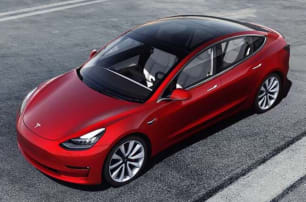The Model 3 is as slick and modern to drive as its design suggests, the minimalist approach extending to your interactions with the car’s inputs.
Visibility is great out the front of the Model 3, with the low dash and abundance of glass making it easy to see in most directions, it is only out the rear where visibility is a bit limited by the tall boot lid.
The steering is somewhat artificial, and has three modes. ‘Normal’ and ‘Sport’ are far too heavy, with 'Comfort' the only mode I’d be using day-to-day. Even then, it was a relief to return to the comparatively featherweight steering of my Kia Niro long termer after my week in the Model 3.
The Tesla is much more fun though, with its absurdly responsive acceleration. Sure, on the numbers it’s only about as fast as a Hyundai i30N, but bloody hell does it feel faster. Dipping your toe into the accelerator simply throws you into the back of your seat, with the corresponding warp in speed anything but smooth. Use it to terrify your friends, family, EV naysayers, and family pets.
As heavy as the steering is, it’s also reactive, combining with the eager acceleration, firm ride, and rear-driven axle to make even this most basic Model 3 a lot of fun to steer.
For everyday driving though, the firm ride can be a bit much. It makes the car feel harsh and brittle, communicating much of the road through to the cabin. The base rear-drive with its 19-inch wheels is more comfortable than the Long Range or Performance grades too, with their bigger alloys, so keep this in mind if you’re shopping up the range. This problem is something the Model 3 shares with the Model Y, so buying the SUV version isn’t going to help.
One advantage the Model Y does get is ride height. The Model 3 is quite close to the ground, making it quite possible for it to scrape on speed bumps and driveways. This, no doubt, is to keep the drag down, but it might be too low for access to some driver’s properties.
The Model 3 is offered with a single regen tune, which can alternatively be switched for a more traditional drive experience where the brake pedal blends the regen in. The standard tune is nice though, with a linear roll-on and instant activation, saving you energy in every possible moment it can. It’s not quite as strong as some rival’s ‘single pedal’ driving modes, but it suits the Model 3 well.
Thanks to the hard ride the Model 3 is not the quietest EV when it come to cabin ambiance, with some road noise and thuds from the suspension being easily heard in the cabin. It also doesn’t emit a noise, with only a high-pitched whine from the rear electric motor when really pushed.
The software continues to be a strong point, with the Model 3 offering a very cool radar screen showing you all the objects around you, even ones you may not have seen, and the fact that there’s no push-start ignition or need to use keys is pretty neat, just hop in and drive, hop out and walk away, the car takes care of the rest.
Finally, the autonomous cruise feature is disturbingly good and deserves a special mention. While it’s hard to recommend the absurdly expensive ‘Full Self Driving’ upgrade ($10,100!) which is dubiously legal and offers you the opportunity to pay to be Elon Musk’s beta tester, the standard adaptive cruise is very good.
It stays in its lane better than pretty much all other active cruise systems I’ve used, is very clever at steering and avoiding objects, although does have a penchant for being a bit heavy on the brakes when in stop-start traffic.
I’d go so far as to say this base Rear-Wheel Drive Model 3 is the pick of the bunch by a long shot. It’s fast and a lot of fun with a futuristic feel from behind the wheel. Sure the steering is heavy and the ride is hard, but it’s easily one of the best EVs to drive right now regardless.

.png)